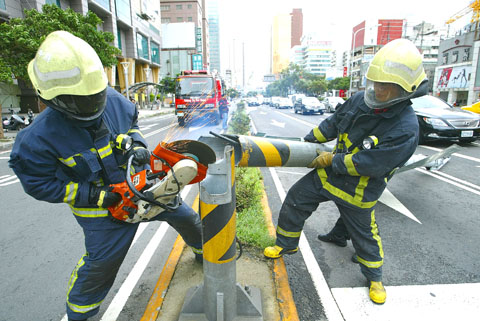The Central Weather Bureau (CWB) said yesterday that the proliferation of typhoons this summer could be caused by the record strength of this year’s La Nina effect. Following a number of tropical storms and typhoons in July and last month, Taiwan has been hit by a typhoon almost every week this month, which the bureau said could be attributable to the westward migration of warm seas.
CWB Forecast Center Director Daniel Wu (吳德榮) said that when storms are formed further away from Taiwan, they gain enough momentum on their way to the country to develop into stronger storms.
Under normal weather conditions, storms usually form around Guam, the bureau said, but as the severe La Nina effect from last July to this July had caused the northwestern Pacific Ocean to be unusually cool, it was difficult for winds to form.

PHOTO: CHAN CHAO-YANG, TAIPEI TIMES
As such, the warmer sea regions migrated to east of the Philippines, where all of the first six typhoons this year were formed, the CWB said, adding that when they hit Taiwan, they were almost all mild storms.
In related news, a day ahead of Super Typhoon Jangmi’s arrival, Taipei City’s vegetable prices shot up 14 percent, with the costs of leafy vegetables and fruits increasing 20 percent.
Spring onions now cost as much as NT$86 per kilogram, cilantro broke the NT$300 per kilogram mark, and fruit has uniformly broken the NT$70 per kilogram benchmark, with tomatoes costing NT$110 per kilogram.

PHOTO: CHANG CHUNG-YI, TAIPEI TIMES
While Typhoon Sinlaku caused NT$890 million in agricultural losses two weeks ago, Jangmi had brought Taipei’s fruit and vegetable prices to NT$35.2 per kilogram — more than the Council of Agriculture’s NT$25 to NT$35 bracket for “reasonable prices.”
Hsu Hang-ching (許漢卿), director of the council’s agriculture and food agency, said it would regulate the market more aggressively, possibly releasing the government’s 900 tonne stock of frozen and refrigerated vegetables if necessary.
ADDITIONAL REPORTING BY LIN SHIU-TZI AND CHANG CHUN-WEI

US climber Alex Honnold is to attempt to scale Taipei 101 without a rope and harness in a live Netflix special on Jan. 24, the streaming platform announced on Wednesday. Accounting for the time difference, the two-hour broadcast of Honnold’s climb, called Skyscraper Live, is to air on Jan. 23 in the US, Netflix said in a statement. Honnold, 40, was the first person ever to free solo climb the 900m El Capitan rock formation in Yosemite National Park — a feat that was recorded and later made into the 2018 documentary film Free Solo. Netflix previewed Skyscraper Live in October, after videos

NUMBERS IMBALANCE: More than 4 million Taiwanese have visited China this year, while only about half a million Chinese have visited here Beijing has yet to respond to Taiwan’s requests for negotiation over matters related to the recovery of cross-strait tourism, the Tourism Administration said yesterday. Taiwan’s tourism authority issued the statement after Chinese-language daily the China Times reported yesterday that the government’s policy of banning group tours to China does not stop Taiwanese from visiting the country. As of October, more than 4.2 million had traveled to China this year, exceeding last year. Beijing estimated the number of Taiwanese tourists in China could reach 4.5 million this year. By contrast, only 500,000 Chinese tourists are expected in Taiwan, the report said. The report

Temperatures are forecast to drop steadily as a continental cold air mass moves across Taiwan, with some areas also likely to see heavy rainfall, the Central Weather Administration (CWA) said. From today through early tomorrow, a cold air mass would keep temperatures low across central and northern Taiwan, and the eastern half of Taiwan proper, with isolated brief showers forecast along Keelung’s north coast, Taipei and New Taipei City’s mountainous areas and eastern Taiwan, it said. Lows of 11°C to 15°C are forecast in central and northern Taiwan, Yilan County, and the outlying Kinmen and Lienchiang (Matsu) counties, and 14°C to 17°C

STEERING FAILURE: The first boat of its class is experiencing teething issues as it readies for acceptance by the navy, according to a recent story about rudder failure The Hai Kun (海鯤), the nation’s first locally built submarine, allegedly suffered a total failure of stern hydraulic systems during the second round of sea acceptance trials on June 26, and sailors were forced to manually operate the X-rudder to turn the submarine and return to port, news Web site Mirror Daily reported yesterday. The report said that tugboats following the Hai Kun assisted the submarine in avoiding collisions with other ships due to the X-rudder malfunctioning. At the time of the report, the submarine had completed its trials and was scheduled to begin diving and surfacing tests in shallow areas. The X-rudder,